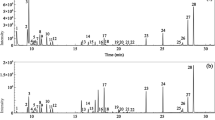Abstract
An analytical procedure for the determination of trihalomethanes (i.e., CHCl3, CHBrCl2, CHBr2Cl, and CHBr3) in leafy vegetable matrices was developed consisting of headspace solid-phase microextraction (HS-SPME) followed by GC-electron capture detector (ECD) determination. Factors affecting the extraction yield were optimized by multivariate methods in two steps. First, a 25-1 fractional factorial design was applied to screen for and assess the effects and interactions of sample mass (g), extraction temperature (°C), extraction time (min), the salting-out effect, and total volume (mL). Second, a response surface methodology design, i.e., central composite design, was applied to optimize the variables found to have a significant impact on the extraction process (extraction time, extraction temperature, and total sample volume), thereby making it possible to simulate the behavior of all the analytes except CHBr3. Finally, the multiple responses were simultaneously optimized using the desirability function. The optimum overall extraction conditions were achieved with an extraction time of 30 min, a temperature of 40 °C, and a total volume of 5 mL. These analytical conditions were validated by spiking plant samples at two concentration levels (2 and 5 mg kg−1), which yielded accurate and precise results for the target analytes. Detection and quantitation limits ranged from 0.09 to 0.64 μg kg−1 and 0.14 to 0.97 μg kg−1, respectively. Finally, chloroform and bromoform were detected in lettuce irrigated with a chlorinated secondary effluent at concentrations of 1.01 and 0.33 μg kg−1, respectively.


Similar content being viewed by others
References
Aggarwal A, Singh H, Kumar P, Singh M (2008) J Mater Process Technol 205:42–50
Akande BC, Ndakidemi PA, Fatoki O, Odendaal J (2010) Afr J Biotechnol 9:1280–1287
Bartha B, Huber C, Harpaintner R, Schröder P (2010) Environ Sci Pollut Res 17:1553–1562
Bellar TA, Lichtenberg JJ, Kroner RC (1974) J Am Water Works Ass 66:703–706
Calderón-Preciado D, Jiménez-Cartagena C, Matamoros V, Bayona JM (2011) Water Res 45:221–231
Díez S, Bayona JM (2008) Talanta 77:21–27
Huang AT, Batterman S (2010) Environ Intl 36:754–762
IARC (1999) IARC monographs on the evaluation of carcinogenic risks to humans. Vol 52. Chlorinated drinking-water. IARC, Lyon
International Panel on Climate Change (IPCC) (2014) Climate change: impacts, adaptation and vulnerability. http://www.ipcc.ch/report/ar5/wg2/ (accessed by April 2014)
Jiménez B, Asano T (2008) Water reuse. An international survey of current practice issues and needs. IWA Publishing, London
Juraske R, Castells F, Vijay A, Muñoz P, Antón A (2009) J Hazar Mater 165:683–689
Llompart M, Li K, Fingas M (1998) Anal Chem 70:2510–2515
Matamoros V, Mujeriego R, Bayona JM (2007) Water Res 41:3337–3344
Mester Z, Sturgeon R, Pawliszyn J (2001) Spectrochim Acta B 56:233–260
Michelini L, Reichel R, Werner W, Ghisi R, Thiele-Bruhn S (2012) Water Air Soil Poll 223:5243–5257
Milly PCD, Dunne KA, Vecchia AV (2005) Nature 438:347–350
Nieuwenhuijsen MJ, Grellier J, Smith R, Iszatt N, Bennett J, Best N, Toledano M (2009) Phil Trans R Soc A 367:4043–4076
Pawliszyn J (1997) Solid phase microextraction: theory and practice. Wiley-VCH, New York
Richardson SD (2008) Anal Chem 80:4373–4402
Symons JM, Bellar TA, Carswell JK, Demarco J, Kropp K, Robeck GG, Seeger DR, Slocum CJ, Smith BL, Stevens AA (1975) J Am Water Works Ass 67:634–647
Waller K, Swan SH, Windham SC, Fenster L (2001) J Exp Anal Environ Epidem 11:522–531
Acknowledgements
This study has been funded by the Catalan Food Safety Agency (ACSA) and the Spanish Ministry of Economy and Competitiveness (MINECO), projects CGL2011-24844. Technical assistance provided by Mrs. Yolanda Rodriguez and Inma Fernández is greatly acknowledged.
Conflict of Interest
Diana Calderón declares that she has no conflict of interest with ACSA and MINECO. Josep M Bayona declares that he has no conflict of interest with ACSA and MINECO.
Compliance with Ethics Requirements
This manuscript has been carefully prepared following the ethical standards given below.
-
The reported data is original and has not been modified or altered.
-
There is no plagiarism in the manuscript.
-
The manuscript is submitted on exclusive basis to this journal.
-
The topic of this manuscript has not been published before.
-
Both authors have significantly contributed to the manuscript writing or data interpretation.
-
This article does not contain any studies with human or animal subjects.
Author information
Authors and Affiliations
Corresponding author
Rights and permissions
About this article
Cite this article
Calderón-Preciado, D., Bayona, J.M. Development of an Analytical Procedure for the Determination of Trihalomethanes in Leafy Vegetable by Headspace-SPME Followed by GC-ECD Determination. Food Anal. Methods 8, 1093–1100 (2015). https://doi.org/10.1007/s12161-014-9965-9
Received:
Accepted:
Published:
Issue Date:
DOI: https://doi.org/10.1007/s12161-014-9965-9




